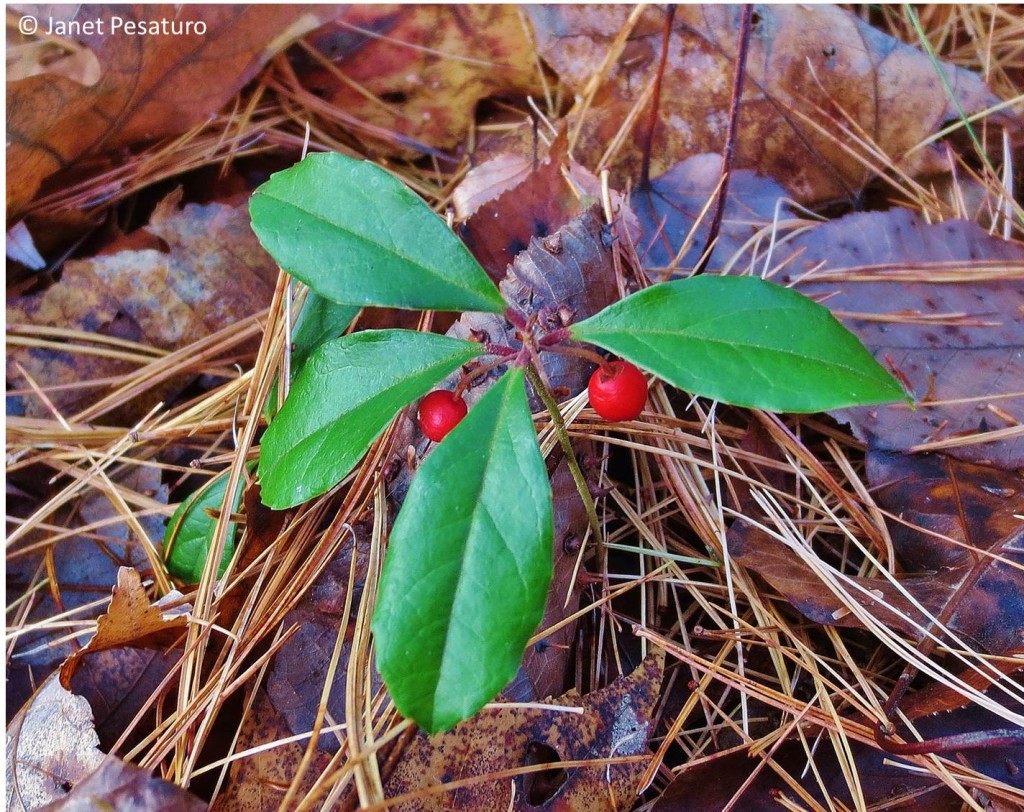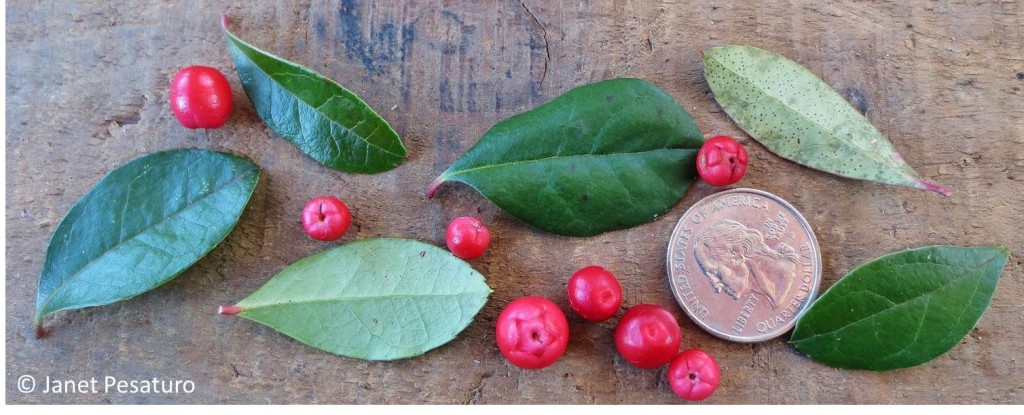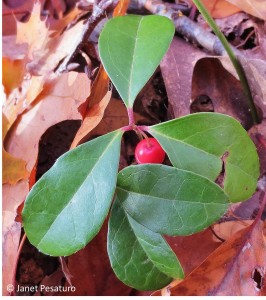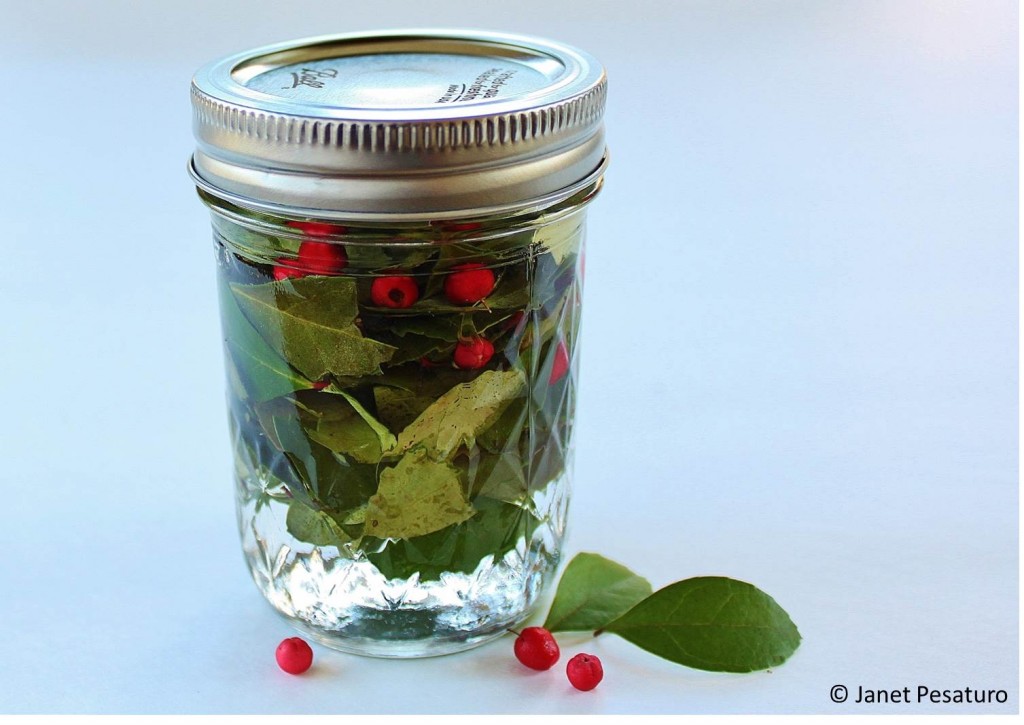Gaultheria procumbens goes by several nicknames in addition to wintergreen: teaberry, checkerberry, deerberry, and boxberry, to name a few. If you’re not familiar with wintergreen flavor, it’s delightfully minty.
Whenever I see this common, diminutive evergreen shrub – yes, it is a shrub – I think of Almanzo and Alice Wilder, (from a favorite children’s book, Farmer Boy, by Laura Ingalls Wilder), pawing through the snow for wintergreen one Saturday afternoon. After snacking on the berries, the two kids gathered up some wintergreen leaves for Mother, who, Laura writes, crammed them into a bottle of whiskey to make the year’s supply of wintergreen flavoring for cakes and cookies. That is, she made wintergreen extract.
That was the 1860’s, when homestead children were responsible for gathering wild nuts, berries, roots, twigs, bark, and leaves that the family needed for food, flavoring, medicine, or dye. What a stark contrast to modern day kids, many of whom cannot distinguish between an oak leaf and a maple leaf! Not that I was much better than the current generation – I certainly could not have identified wintergreen in the woods was when I was a kid, and I had to learn from Laura Ingalls Wilder how to make wintergreen extract.
General characteristics of wintergreen
This tiny evergreen shrub reaches about 6 inches in height and spreads by means of long rhizomes. The oval leaves are 1-2 inches long. While there are many other little plants with oval leaves gracing the forest floor, wintergreen leaves have a distinctive minty scent when torn.
As a member of the heath family (Ericaceae), G. procumbens is closely related to blueberries, huckleberries, and cranberries, also in the heath family. In fact, wintergreens’s spring blooms look very much like blueberry and huckleberry flowers (scroll down at that link to see my photos of blueberry and huckleberry flowers). But, nodding under leaves only a few inches off the ground, wintergreen flowers usually go unnoticed.
The flowers are followed by bright red berries, about 1/4 to 3/8 inch in diameter. The berries have a distinct wintergreen flavor, but they are not juicy; the texture is about as appealing as styrofoam. They ripen in fall and persist into winter.
Where to find wintergreen
It grows in most of eastern North America, according to the USDA Plants Database range map. Like other members of the heath family, it prefers acidic soils. It is often found in pine/oak forests, especially where other heath family shrubs (like blueberry and huckleberry) grow.
Here in Massachusetts, wintergreen is very common in white pine / mixed oak forests. In some locations it literally carpets the forest floor; elsewhere it is sparsely distributed.
Edibility of wintergreen
The edible berries have been used in many recipes, and the leaves can be used to make a wintergreen flavored tea, cordial, or extract. The minty flavor comes from the chemical methyl salicylate, produced by the plant. In fact, pure oil of wintergreen is methyl salicylate. People used to distill it from Gaultheria procumbens, or from another plant which produces it, the black birch (Betula lenta). But these days, pure oil of wintergreen is chemically synthesized.
The nerds among us might recognize that methyl salicylate sounds a lot like acetyl salicylate, or aspirin. And it is a lot like aspirin. Like aspirin, it has medicinal qualities, such as anti-inflammatory and anti-fever properties. And, like aspirin, pure oil of wintergreen is toxic in large enough quantities. How large is large enough? A teaspoon (7 grams) of pure oil of wintergreen can kill an adult, and 4.7 grams can kill a child, as you can see here. But relax. An alcohol extract is not pure oil of wintergreen, and you wouldn’t consume a whole teaspoon at once. You would add about a teaspoon of an extract to an entire batch of cookies.
How many wintergreen berries can you safely eat? I don’t know. But I do know that the berries are a common wild edible used by hikers as a snack, and I’ve never heard of a wintergreen eating hiker die of salicylate poisoning. The thing is, that styrofoam texture of the berries is just not that appealing, so you wouldn’t want to eat them by the handful, the way you eat blueberries. So don’t eat them by the handful. Enjoy the minty flavor of an occasional berry.
Unsure you’ve got the right plant? Then double or triple check with other sources until you are certain. Never eat a wild plant unless you are sure of its identity and know that it’s edible.
How to forage for wintergreen
I do snack on wintergreen berries in the woods sometimes, but I don’t like to pick a lot of them because they are not produced in great abundance. If you want to make something with them, there are many recipes using them on the web; search for teaberry cake, cookies, ice cream, etc. Instead, I prefer to harvest the leaves, because not many are needed to make an extract that will last a long time. Here’s how you can harvest to minimize impact:
- Take only one leaf per stem (per cluster of leaves).
- Take from clusters that are spaced at least a few feet apart.
- Try not to trample it all out as you harvest; take some of what you need from clusters that you can reach from the trail.
- Harvest where it is relatively abundant, not where you find just an occasional, pathetic looking, struggling plant.
Because this tiny shrub is evergreen, you can harvest leaves at any time of year. I haven’t really noticed the scent of the leaves varying in intensity over the course of the year, so I don’t think it matters much. Berries persist into winter, but I think they’re better in fall. The only reason to pick them in winter, as far as I can see, is that there are no other berries in the woods at that time of year.
How to make wintergreen extract
- Add torn wintergreen leaves to a small jar until 2/3 to 3/4 full.
- Pour in enough 80 or 100 proof vodka to cover the leaves.
- Cap the jar, shake it, and keep it in a dark place at room temperature for at least a month. Shake the jar every day or two.
- Taste it every now and then to see how strong it is. After 6 weeks, or longer, if necessary to develop a strong flavor, strain out the leaves and discard them.
You can use whiskey, like Almanzo and Alice’s mother did, but that will add some flavor of its own, whereas vodka does not. You do not need to add any berries. I did so just to make the photo pretty. They fade to an ugly sand color within 24 hours, anyway, so don’t bother unless your plan is to photograph it right after mixing, to show it off in a stellar blog post ;o)
Looking for a creative way to use wintergreen extract? Try my wintergreen ice cream brownie torte. It’s rustic, beautiful, and delicious!
Shared on: Time Travel Thursday #176, HomeAcre Hop, From the Farm hop, Simply Natural Saturdays, Independence Day Challenge, Homesteaders Hop #20, Homestead Barn Hop #138, Natural Living Monday, Mostly Homemade Monday #57, Thank Goodness it’s Monday #47, Backyard Farming Connection #59, Creative Home and Garden Hop #20, Frugal Days, Sustainable Ways #100, Old-Fashioned Friday #46, Freedom Fridays, Wildcrafting Wednesday#119, Weekend Wholefood Blender Party, Tuesday Greens #59















This was great! We shared with our FB readers at homesteadlady.com.
Thank you so much, Tessa!!
Great post! It’s my favorite for this week’s From the Farm Blog Hop, so thanks for linking up and be sure to come back next week to grab your ‘favorites’ button! I just started the Intermediate Herbal Class at the Herbal Academy of New England and am reading all I can about herbs, so this was super interesting to me. There’s a link to the online course info on my blog if you are interested – sounds like you love foraging for herbs and concocting stuff too!
Lisa
Fresh Eggs Daily
http://www.fresh-eggs-daily.com
Thanks so much for the information. We have some of these plants on our property and am happy knowing I can actually use them!
Lisa, thank you so much!! Yes, I do love foraging and concocting with wild herbs, nuts, berries, etc. The course looks great, I’m sure you’ll have a blast with it.
Pingback: The HomeAcre Hop #48
Pingback: Modern Homesteaders Blog Hop | The Homesteading Hippy
Pingback: The Homesteaders Hop #21 & Thankful Thanksgiving Results | Modern Homesteaders
Pingback: Homesteaders Hop #21 & Contest Results!
Pingback: Homesteaders Hop #21 & Contest Results
Pingback: Wintergreen ice cream brownie torte - One Acre Farm
I love this tutorial, it’s great to be able to show people they can take charge in their own healthcare and make their own herbal extracts 🙂
I’ve recently started a blog party focused on wholefood drink recipes including home remedies and I would love if you would ever like to link up in the future. It’s called the Weekend Wholefood Blender Party and runs every Sunday to promote smoothies, juices, herbal teas, fermented beverages and home remedies. Have a fabulous week and thanks for this amazing home remedy!
Thanks, Ally. I have sent you a private message asking you some questions about what’s appropriate for your blog party. Looks like a great idea; thanks for hosting it!
Can you drink the extract concoction after it is finished?
I wouldn’t. Salicylate can be dangerous in large enough quantities. This is to be used as a flavoring — a teaspoon or so, added to batch of cookie or cake batter, for example.
Pingback: Wintergreen Extract from Birch - One Acre Farm
Pingback: The Homesteaders Hop #21 & Thankful Thanksgiving Results | Heritage Homesteaders
I’m very pleased to find this great site.
I want to to thank you for your tome for this fantastic read!!
I definitely appreciated eveery little bit of it and I have you book marked to see new stuff in youjr site.
Greate article. Keep writing such kind of information on your
page. Im really impressed by your blog.
Hey there, You have done an excellent job. I will definitely digg it and for my part recommend to my friends.
I’m confident they’ll be benefited from this site.
Pingback: 10 Selfish Reasons to Protect Biodiversity - One Acre Farm
Thanks for finally writing about > Wintergreen:
how to harvest it and make an alcohol extract – One Acre Farm < Liked it!
Pingback: 4 Wild Winter Teas and a Chocolate Drink - One Acre Farm
Swissquote: They set aside 25 million CHF due to Swiss Franc volatility.
Can you use the extract to flavor water for a kind of wintergreen like taste? If so, how much would I add to an 8 oz. glass of water? How many such glasses then could be a person drink and still be safe?
Inspiring. We have bachelor’s buttons and snakeroot in FL. Methyl salicylate is found in roots of both.The roots of the former have strong aroma of wintergreen. The latter has been used medicinally.
How come I can’t find checkerberry extract to buy anywhere
Pingback: Local Healthy Foraging
What a wonderfully stellar post indeed! You’re informatively descriptive instructions leave me without question and ready to embark. Thank you Janet for being intelligent enough to put that all together and sharing it with us, I love it when I randomly learn cool things while I’m reading. Awesome!
That was a great article! Thank you, especially the part about picking only one leaf per stem and avoiding picking the berries. I found a small planting in my back yard, and it is time to distill.
how would you make tea and how much is safe to drink and what would the benefits be medicinally?
Also can you use the xtract as a medicinal I don’t intend to cook with it …so if so for what and again how.
Thank you so much just picked the leaves today and want to get right on it!
We have 23 acres of forest and wild wintergreen is all over the ground. Great article ! not sure when the best time to harvest is?
Is there a way to candy the berries? How else can you preserve them? Thanks
Pingback: Thirsty Thursdays: The Canada Mint Cocktail – Aged.
Loved your story. We like using wintergreen alcohol. We can’t find it right now. We make a liniment with it using camphor and kerosene. Works wonders for every day aches and pains..
Can a plant be bought somewhere, so that I could plant it and harvest my own leaves from its growth? I live in Deep South Texas, very close to the Mexican border. I look forward to hearing back. Thank you